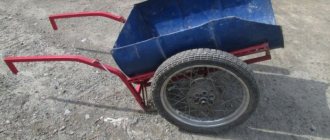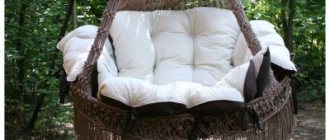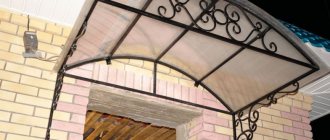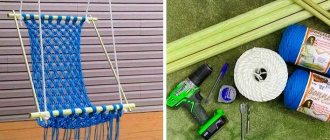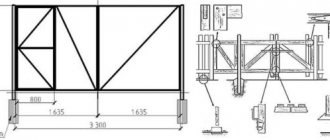Compared to a bed, sofa or chaise lounge, a hammock has a huge advantage in the sense that resting on it restores strength much better. The invention is not new - the Mayan Indians came up with it. This invention has not lost its relevance to this day.
In addition to sleep, you can read and drink tea without getting out of your cozy bed. Types of hammocks for a summer residence, with photos and illustrations, as well as rules for their operation, decor options - further in the article.
Fast delivery of air conditioners from the official manufacturer Haier with free installation
Do you need a hammock at your dacha?
If you are the lucky owner of a summer house, then this is a great opportunity to escape from the noisy bustle of the city.
It is at the dacha that you really want to feel connected to nature and a hammock is an excellent opportunity to have a good rest, sleep and find peace in your own soul.
It’s quite easy to make a hammock for a summer house with your own hands, the main thing is to calculate your financial and creative capabilities. Before you start equipping a hammock, you can select the material, fabric, frame and its location. Also, don't be afraid to experiment.
fashion element
The modern hammock is ubiquitous. Having become a fashion trend, it is penetrating into homes, apartments, and offices, where hanging relaxing chairs are increasingly being placed in rest areas for employees.
It will fit into almost any interior. A good designer hammock will become a bright stylish detail for a private home. It can be placed on the balcony, veranda, attic.
- Do-it-yourself mailbox - a detailed description of how and what to make a beautiful and convenient mailbox for letters (80 photos and videos)
Flowerbed made from bottles - a master class in making original flowerbeds. 120 photos of decorating a flower bed using plastic
Garden furniture - tips on selection, use and care. Rules for placement and nuances of choosing material (105 photos)
As a decorative element it would be quite appropriate in the bedroom and even in the living room. Hanging “chairs” will comfortably replace a sofa near the TV.
Which hammock to choose for your home or cottage?
The size of the hammock should match the location where you plan to place it. It shouldn't be too big, but it shouldn't be too small either.
If you are making a hammock for yourself and not for children, then the size of such a hammock should be one and a half to two meters, otherwise it will be extremely uncomfortable to fit in it.
Criteria to consider when making a hammock: The material or fabric you are planning to make the hammock from. threads for a wicker hammock. types and strength of supports. the size of the hammock and the length at which it will be hung.
Iron pillars
To install a hammock you will need two iron posts with a diameter of 15-20 cm, metal fasteners and cement mortar. The pillars must be installed at the same distance as the wooden beams, holes for them must be dug in the ground at least a meter deep, and concreted. After the solution has hardened, you can attach the hammock in the usual way.
Fabric hammock
One of the main elements of a hammock is the fabric. The choice of fabric must be approached very responsibly. The shelf life of the hammock will depend on what fabric you choose.
The fabric should be thick enough. For example, it could be a tarpaulin. It is better to abandon synthetic materials, as they negatively affect the health of the person who will relax on the hammock.
Material selection
Fastenings and fabric need to be durable and able to last for more than one season.
Hanging fabric
Durable fabric is preferable, natural is better:
- mattress linen;
- cotton fabric;
- tarpaulin;
- sackcloth.
Along with durability, comfort is taken into account. In this regard, tarpaulin and burlap are significantly inferior to cotton fabrics. Rough fabric is not very comfortable for the body.
Mattress fabric and any other cotton fabric are pleasant to the touch and can withstand loads of up to 160 kilograms
Hanging mesh
The easiest to manufacture, lightweight, does not take up much space when transporting. The downside is that the maximum load threshold is 100 kilograms; it can’t handle two adults. Lying in it is not very comfortable - the mesh will dig into the body.
If you still choose this option, it is best to choose cotton threads for weaving.
If you know the technique of weaving macrame, tie a hammock yourself, it will be elegant and unusual.
Frame
Metal pipes or wooden slats are suitable for making the base. Prefabricated structures are usually made from metal. The wooden frame is monumental and low mobility.
The principle of choosing fabric is the same as for hanging models - reliability, comfort, durability.
There is a lot of room for imagination and ideas. When weaving using the macrame technique, you can use a child. It is useful for children to create homemade products together with their parents.
Hammock frame
The frame for a hammock is usually made of wood. This makes it very durable and stable. The frame can be a full-fledged structure or, on the contrary, consist of small planks that hold the entire hammock.
To make a frame, you need to take several planks of the same size and small thickness. First you need to place one board horizontally, then attach some kind of stands to both sides, attach boards vertically and at an acute angle along the edges.
Hiking with your own bed
The scope of hammocks is wide. It would seem like a vacation and nothing more. But rest is a flexible concept. Practical products for tourists, compact, lightweight, made from the strongest parachute silk, have long been a separate group.
Special fastenings allow you to stretch the travel hammock even between rocks! You can cover yourself with it like a blanket or put it under your head instead of a pillow.
The capacity figure is also impressive. The industry produces real family boxes for three people that can withstand 230 kg or more. They are sewn from especially durable cotton with a special weave of fabric.
Types of hammock supports
Some consist of a large number of supports, others contain a frame or are completely woven from threads. The shape of the hammock and its appearance depend entirely on personal preference.
If you look at a photo of a hammock made by yourself, you might be surprised at how diverse they can be. The most common type of support today is a frame on which finished fabric or threads are hung.
As a support, you can choose two trees located at a distance of several meters from each other. Then the largest tree branches are used as fastenings.
Swing
A hammock swing for a summer cottage cannot quite be classified as a separate type. Such a model can be with or without a frame, it can be traditionally oblong or in the form of a chair. A distinctive feature of the swing is its single attachment point. It is because of this that the hammock is able to swing.
Striped hammock for the garden
Children will be especially happy with such an unusual design. These swings are absolutely safe, so kids can play in them without adult supervision. For an additional fee, you can make an original appearance that will further win the child’s heart.
Hammock for a summer house with a canopy
How to make a hanging hammock with your own hands?
There are several ways to make a hammock with your own hands. To make the simplest and most inexpensive hammock, you will need fabric and thick threads.
- Such a hammock is placed between two trees, which serve as both a frame and supports.
- To hang a hammock on a tree, on the ends of the fabric, you need to tie threads or attach them using a board and threads.
- We attach the finished hammock to the branches using threads. Please note that the branches must be large and the threads must be dense enough.
- A more expensive option is a hammock with a frame. In this case, you will need to make a frame as described above, then select the fabric.
- Using threads, attach the selected fabric to the frame. Thus, a hammock at home is a great option for rest and relaxation.
- When spending time at the dacha, you will get great pleasure from spending time on a hammock. In this position you can even work, sleep in the afternoon, read a book or play with children.
The main thing is that the hammock is located in a place where the sun's rays do not have a strong impact on a person. It is best if the hammock can be moved from one place to another.
Wooden pillars
The distance between the logs should be 30 cm greater than the length of the hammock fabric. There are several mounting options.
- The simplest is to dig two wooden posts at least 1.5 meters deep and use them for fastening like trees. The difference is that the rope on the beams can be secured more efficiently using self-tapping screws.
- A more complicated method is to build a rectangular structure of four beams and horizontal crossbars located at the top. The attachment points can be placed in the upper corners of the resulting “rectangle”.
How to make your own hammock, see our instructions.
Photo of a hammock made by yourself
Do-it-yourself Alpine slide - the best ideas, construction schemes, design options and location rules (115 photos)DIY playground - 110 photos and a review of the best ideas on how and what to build a playground from
Do-it-yourself landscape design - expert advice and practical guidance on applying the current style (115 photos)
Did you like the article?
Under the ceiling
A hammock under the ceiling will look beautiful. Such a solution will add exoticism and aesthetics to the interior. It is best to choose hammocks in the form of a net as they look much better.
Safety is important. You can place soft pillows or a sports mat under the hammock so that children do not get injured if they fall.
Rafter-webbing suspension system
The finished hammock is equipped with slings (straps). They are a mandatory structural part of the product. Slings are a continuation of the product. The slings include connecting elements and grips:
- rope branches;
- links;
- hooks;
- rings;
- staples;
- carbines.
Slings (straps) are made of thick rope or belt. To create one of the common variants of the rafter-webbing system, a belt 8 m long is taken. Then it is divided into 4 segments. They can be equal in length or different. If the length is not kept the same for all segments, then equal sizes are set for paired straps.
A knot is tied on the carabiner.
An adjustment bar can be used. Then the installed product will receive an aesthetic appearance and become more convenient to use.
The belt is threaded in one direction and pulled out the other.
The belt is passed through the hole in the carabiner. Then it is inserted into the adjustment bar.
The end of the belt is brought out.
The end of the belt (tail) must be fixed.
This place is stitched with dense nylon thread. Sewn with small, dense stitches. You will have to sew 3 layers. Alternatively, you can install one metal rivet.
4 straps are constructed and attached to the rim (harness) on four sides with carabiners.
The slings are tied in pairs (on both sides) to a bar horizontally located between the branches of the trees. The distance between the slings should be 40–60 cm. The length of the straps can be adjusted, giving different configurations to this piece of furniture.
To customize the seat, the front straps are made longer and the rear straps shorter.
Rafter-webbing systems allow hanging loungers to be used as chairs and swings. This type of fastening is quite reliable and less labor-intensive. There is no need to carry out complex calculations or consult drawings in the smallest detail.

